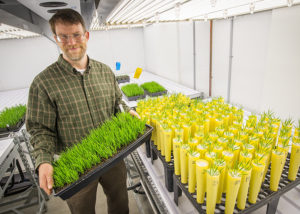Finding a grass gene impacting stomatal morphology underscores importance of developing mutant gene index.

John Vogel with Brachypodium plants at the DOE JGI. (Roy Kaltschmidt, Berkeley Lab)
The Science
The evolution of adjustable pores, stomata, allows plants to control the amount of CO2 that enters the plant and water that escapes by modifying the stomatal pore size. Plants have evolved two kidney shaped guard cells that swell to create the stomate. In grasses, however, they have further evolved with the addition of two subsidiary cells flanking the guard cells-which may be linked to improved stomatal physiology. In a study, researchers identified a transcription factor needed for subsidiary cell formation using a genetic screen.
The Impact
Subsidiary cells, unique to grasses, have been linked to an improved physiological performance by allowing a greater range of pore size and quicker stomatal responsiveness. The ability to better control water loss and increase carbon assimilation in plants could affect its ability to handle stressors such as drought, and play a role in the health and yields of candidate bioenergy feedstocks. Understanding the bases for water management could aid the identification and selection of individuals better suited for growing in otherwise marginal soils.
Summary
Brachypodium distachyon is a small, rapidly growing grass that serves as a model for candidate bioenergy grasses such as Miscanthus and switchgrass. For this reason, in 2010, the B. distachyon genome was sequenced and annotated as part of the U.S. Department of Energy’s (DOE) Joint Genome Institute (JGI), a DOE Office of Science user facility, Community Science Program (CSP). To further accelerate research in the development of biofuel feedstocks, a project to sequence thousands of B. distachyon mutants was selected for the 2015 CSP portfolio. This library of sequenced mutants will aid researchers to study and rapidly identify and order plants with mutations in any gene in its genome.
Using a forward genetic screen, a Stanford University team led by Dominique Bergmann identified a B. distachyon subsidiary cell identify defective (sid) mutant; as a result, the mutant is unable to produce subsidiary cells. By comparing the whole genome sequence of B. distachyon with the sid mutant a 5-base pair deletion of that encodes for the transcription factor BdMUTE was discovered. Further, BdMUTE was identified as mobile transcription factor responsible for coordinating the development of subsidiary and guard cell complexes. The unique subsidiary cells in grasses may allow for an enhanced performance when stressors such as increased temperature or drought are placed on the plant. Though his contribution to the work predates his time at the DOE JGI, Plant Functional Genomics lead and study co-author John Vogel provided the team with the mutant population and showed them how to manipulate the plant for their studies.
Contacts
Daniel Drell, Ph.D.
Program Manager
Biological Systems Sciences Division
Office of Biological and Environmental Research
Office of Science
U.S. Department of Energy
[email protected]
John Vogel
Plant Functional Genomics Lead
DOE Joint Genome Institute
[email protected]
Funding
- U.S. DOE Office of Science
- Swiss National Science Foundation
- The Gordon and Betty Moore Foundation
- National Science Foundation
- Howard Hughes Medical Institute
Publications
M.T. Raissig, J.L. Matos, M.X.A. Gil, A. Kornfeld, A. Bettadpur, E. Abrash, H. Allison, G. Badgley, J.P. Vogel, J.A. Berry, D.C. Bergmann. “Mobile MUTE specifies subsidiary cells to build physiologically improved grass stomata.” Science. (2017). [doi:10.1126/science.aal3254]
Related Links
- Stanford Press Release: Scientists reveal how grass developed a better way to breathe
- DOE JGI Scientist John Vogel
- DOE JGI Brachypodium Resources
- DOE JGI Plant Flagship Genomes
- DOE JGI News Release: First Wild Grass Species and Model System for Energy Crops Sequenced
- Brachypodium distachyon on Phytozome portal
- DOE JGI: Indexed Collection of Brachy Mutants